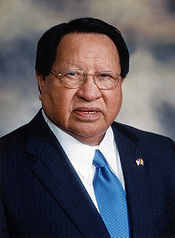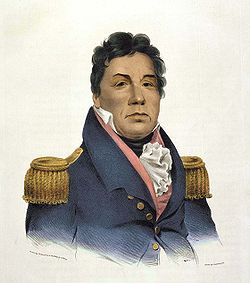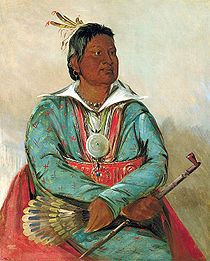
List of Choctaw chiefs
Encyclopedia

Alabama
Alabama is a state located in the southeastern region of the United States. It is bordered by Tennessee to the north, Georgia to the east, Florida and the Gulf of Mexico to the south, and Mississippi to the west. Alabama ranks 30th in total land area and ranks second in the size of its inland...
, Louisiana
Louisiana
Louisiana is a state located in the southern region of the United States of America. Its capital is Baton Rouge and largest city is New Orleans. Louisiana is the only state in the U.S. with political subdivisions termed parishes, which are local governments equivalent to counties...
, Mississippi
Mississippi
Mississippi is a U.S. state located in the Southern United States. Jackson is the state capital and largest city. The name of the state derives from the Mississippi River, which flows along its western boundary, whose name comes from the Ojibwe word misi-ziibi...
, and Oklahoma
Oklahoma
Oklahoma is a state located in the South Central region of the United States of America. With an estimated 3,751,351 residents as of the 2010 census and a land area of 68,667 square miles , Oklahoma is the 28th most populous and 20th-largest state...
.
The Original Three Divisions

Okla Hannali (Six Towns)
- PushmatahaPushmatahaPushmataha , the "Indian General", was one of the three regional chiefs of the major divisions of the Choctaw in the nineteenth century. Many historians considered him the "greatest of all Choctaw chiefs"...
- Oklahoma or Tapenahomma (Nephew of Pushmataha)
- General Hummingbird
- Sam Garland
District Chiefs in the New Indian Territory
After removalChoctaw Trail of Tears
The Choctaw Trail of Tears was the relocation of the Choctaw Nation from their country referred to now as the Deep South to lands west of the Mississippi River in Indian Territory in the 1830s...
, the Choctaws set up their government also divided up in three regions: Apukshunnubbee, Mushulatubbee, and Pushmataha. The regions were named after the three influential Choctaw leaders of the "old country."
Moshulatubbee District

- Mushulatubbee, 1834–1836
- Joseph Kincaid, 1836–1838
- John McKinney, 1838–1842
- Nathaniel Folsom, 1842–1846
- Peter Folsom, 1846–1850
- Cornelius McCurtain, 1850–1854
- David McCoy, 1854–1857
Apukshunnubbee District
- Thomas LeFlore.............1834-1838
- James Fletcher.............1838-1842
- Thomas LeFlore.............1842-1850
- George W. HarkinsGeorge W. HarkinsGeorge W. Harkins was an attorney and prominent chief of the Choctaw tribe during the Indian removals. Elected as principal chief after the national council deposed his maternal uncle, Greenwood LeFlore, in 1834 Harkins was elected judge of the Red River District in Indian Territory...
, 1850–1857
Pushmataha District
- Nitakechi..................1834-1838
- Pierre Juzan...............1838-1841
- Isaac Folsom...............1841-1846
- Nitakechi.......................Died
- Salas Fisher...............1846-1854
- George Folsom..............1850-1854
- Nicholas Cochnauer.........1854-1857
Unified leadership as governor
- Alfred Wade..................1857-1858
- Tandy Walker.................1858-1859
- Brazil LeFlore...............1859-1860
Provisional Chiefs
- George Hudson..............1860-1862
- Samuel Garland.............1862-1864
- Peter PitchlynnPeter PitchlynnPeter Perkins Pitchlynn , or Hat-choo-tuck-nee , was a Choctaw chief of Choctaw and Anglo-American ancestry...
............1864-1866 - Allen Wright...............1866-1870
- William Bryant.............1870-1874
- Coleman Cole...............1874-1878
- Isaac Garvin...............1878-1880
- Jack McCurtain.............1880-1884
- Edmund McCurtain...........1884-1886
- Thompson McKinney..........1886-1888
- Ben Smallwood..............1888-1890
- Wilson Jones...............1890-1894
- Jefferson Gardner..........1894-1896
- Green McCurtainGreen McCurtainGreenwood "Green" McCurtain was Principal Chief of the Choctaw Nation and , serving four two-year terms. He was the third of his brothers to be elected as chief, and after 1906 and the dissolution of tribal governments under the Dawes Act, he was appointed as chief by the United States government...
............1896-1900 - Gilbert Dukes..............1900-1902
The Choctaw Nation was temporarily discontinued in 1906 with the advent of Oklahoma statehood.
Choctaw Nation "token" government
Chiefs were appointed by the U.S. President after dissolution of the Choctaw nation.- Green McCurtain..............1902-1910 Appointed by President
- Victor Locke, Jr.............1910-1918 Appointed by President Howard Taft
- William F. Sample............1918-1922 Appointed by President Woodrow Wilson
- William H. Harrison..........1922-1929 Appointed by President Warren G.Harding
- Ben Dwight...................1930-1936 Appointed by President Herbert Hoover
- William Durant...............1937-1948 Appointed by President
- Harry J.W. Belvin............1948-1975 Appointed by President
Current tribes
Indian termination policyIndian termination policy
Indian termination was the policy of the United States from the mid-1940s to the mid-1960s. The belief was that Native Americans would be better off if assimilated as individuals into mainstream American society. To that end, Congress proposed to end the special relationship between tribes and the...
was a policy that the United States Congress legislated in 1953 to assimilate the Native American communities with mainstream America. In 1959, the Choctaw Termination Act was passed. Unless repealed by the federal government, the Choctaw Nation of Oklahoma would effectively be terminated as a sovereign nation as of August 25, 1970.
In 1945, lands in Neshoba County, Mississippi
Neshoba County, Mississippi
-Demographics:As of the census of 2000, there were 28,684 people, 10,694 households, and 7,742 families residing in the county. The population density was 50 people per square mile . There were 11,980 housing units at an average density of 21 per square mile...
and the surrounding counties were set aside as a federal Indian reservation
Indian reservation
An American Indian reservation is an area of land managed by a Native American tribe under the United States Department of the Interior's Bureau of Indian Affairs...
. There are eight communities of reservation land: Bogue Chitto
Bogue Chitto, Mississippi
Bogue Chitto is a census-designated place in Kemper and Neshoba Counties in the U.S. state of Mississippi. The population was 533 at the 2000 census. It should not be confused with the other Bogue Chitto, which is an unincorporated area in Lincoln County....
, Bogue Homa, Conehatta
Conehatta, Mississippi
Conehatta is a census-designated place in Newton County, Mississippi, United States. The population was 997 at the 2000 census.-Geography:Conehatta is located at ....
, Crystal Ridge, Pearl River
Pearl River, Mississippi
Pearl River is a census-designated place in Neshoba County, Mississippi, United States. The population was 3,156 at the 2000 census.-Geography:Pearl River is located at ....
, Red Water, Tucker
Tucker, Mississippi
Tucker is a census-designated place in Neshoba County, Mississippi, United States. The population was 534 at the 2000 census.-Geography:Tucker is located at ....
, and Standing Pine
Standing Pine, Mississippi
Standing Pine is a census-designated place in Leake County, Mississippi, United States. The population was 509 at the 2000 census.-Geography:Standing Pine is located at ....
. The Indian Reorganization Act of 1934 allowed the Mississippi Choctaws to become re-organized on April 20, 1945 as the Mississippi Band of Choctaw Indians.
Choctaw Nation of Oklahoma
- Harry J.W. Belvin, 1971–1975
- C. David Gardner, 1975–1978
- Hollis E. RobertsHollis E. RobertsHollis Earl Roberts was a leader of the Choctaw Nation of Oklahoma. He was elected as principal chief of the tribe in 1978, having served as a Hugo City councilman and as a member of the Oklahoma House of Representatives. His term as chief ended in 1997 when he was convicted of sex offences...
, 1978–1997 - Gregory E. PyleGregory E. PyleGregory E. Pyle is a leader of the Choctaw Nation of Oklahoma. He was elected as principal chief in 1997 and served until 2011. He has Choctaw, Cherokee and European ancestry.-Early life:...
, 1997–present
Mississippi Band of Choctaw Indians
- Joe Chitto
- Emmette York
- Calvin Isaac
- Phillip MartinPhillip MartinPhillip Martin was the democratically elected Tribal Chief of the Mississippi Band of Choctaw Indians, a federally recognized American Indian tribe of 8,300 enrolled members living on or near 30,000 acres of reservation land in east central Mississippi...
, 1978—2007 - Beasley DensonBeasley DensonBeasley Denson served as Miko or Tribal Chief of the Mississippi Band of Choctaw Indians from 2007 to 2011. He is the third person to become Tribal Chief since the tribe adopted its modern constitution....
, 2007—2011 - Phyliss J. Anderson, 2011—present

